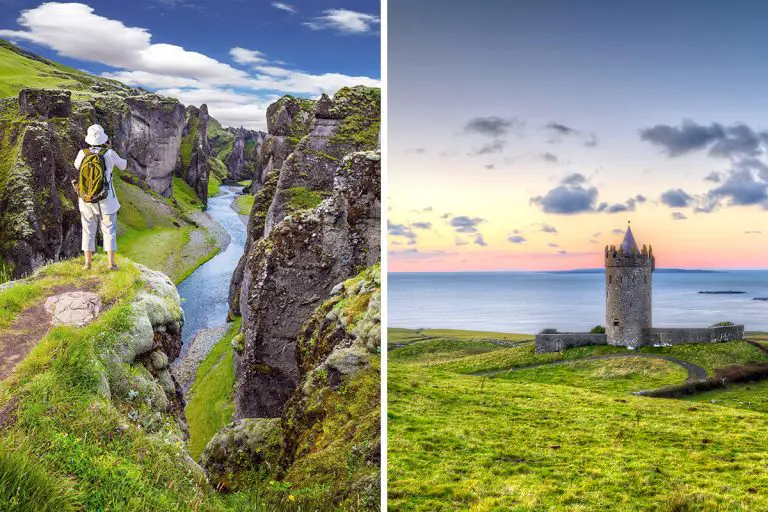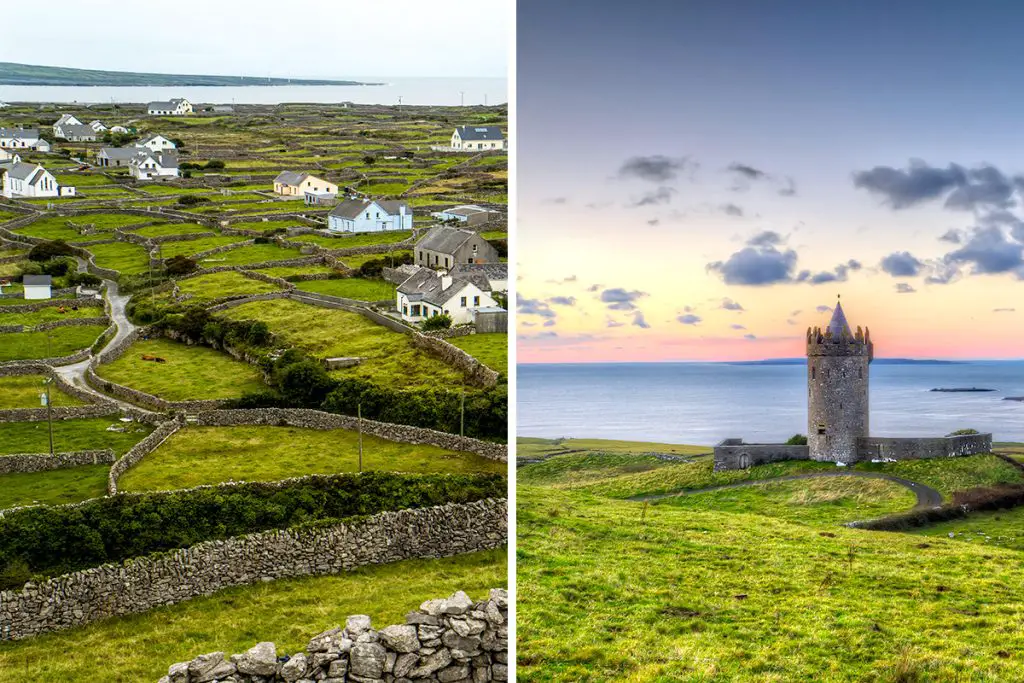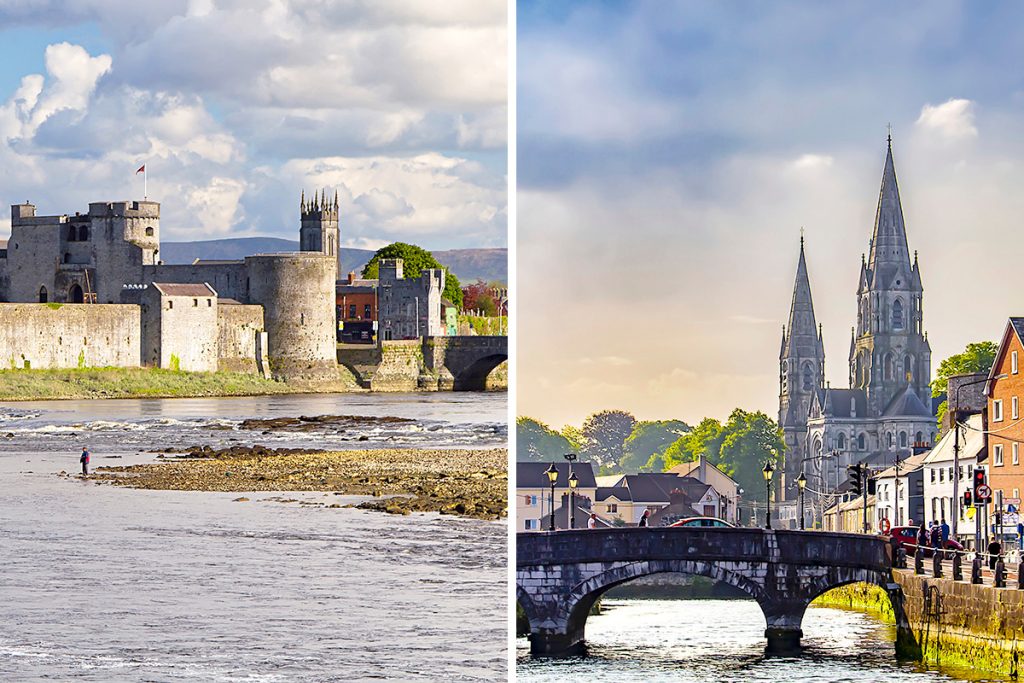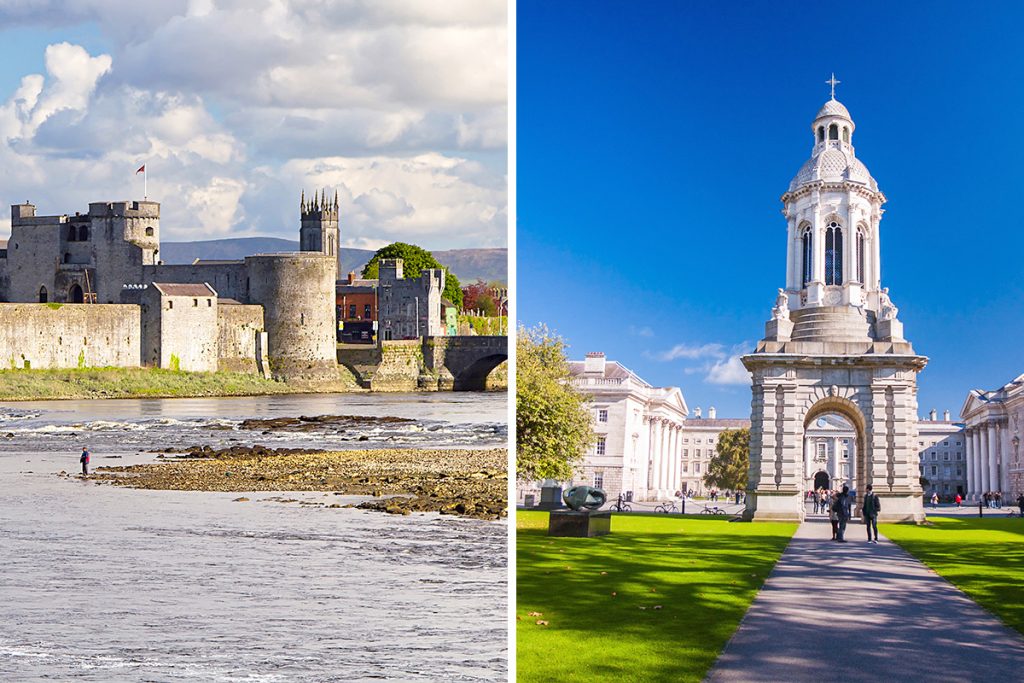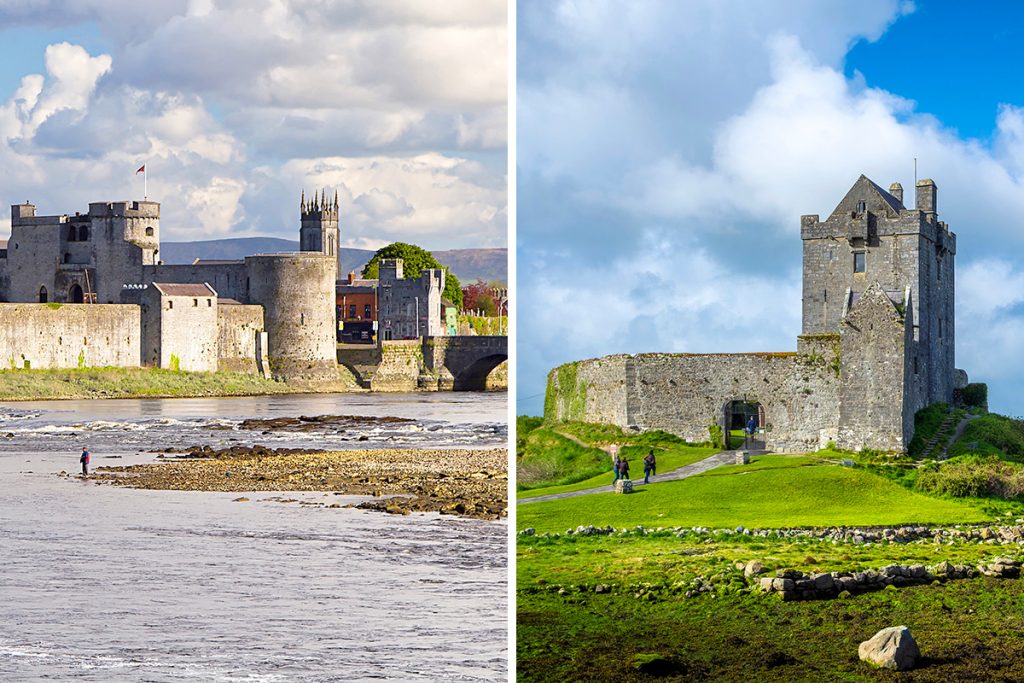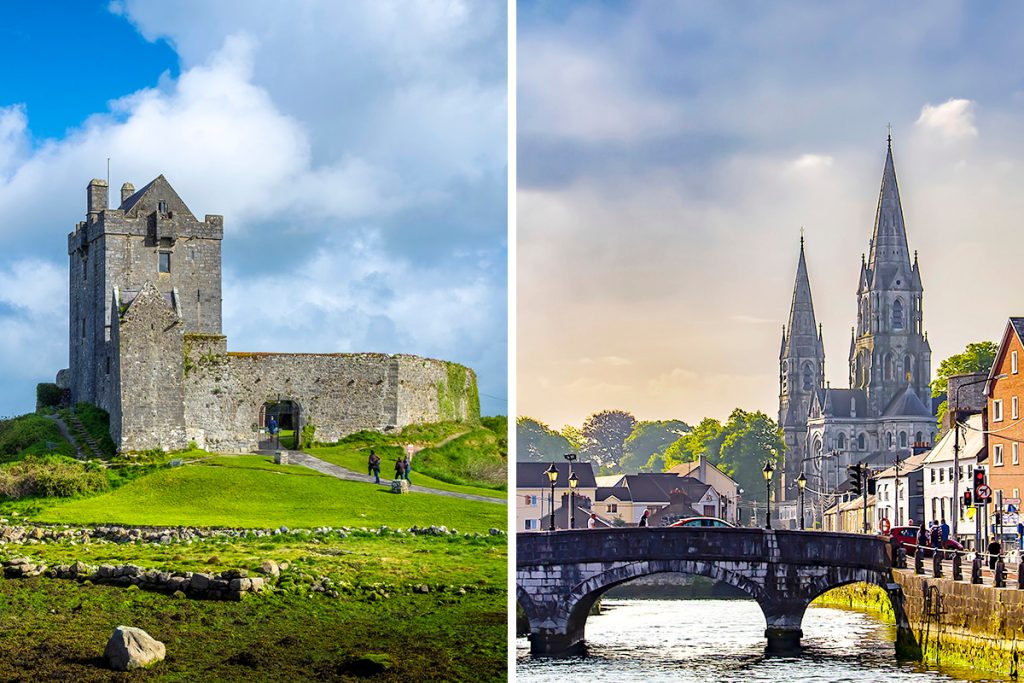Journeying to either Iceland or Ireland promises an adventure brimming with cultural exploration and historical discoveries. The tales waiting to be unfolded in these lands may forever change how you perceive the world. So, why not dive deeper into their histories and cultures? It might just make your decision a little easier.
History & Culture
Let’s embark on a time journey and take a peek at the histories and cultures of Iceland and Ireland.
In Iceland, the history dates back to the ancient seafarers, the Vikings. Originating from Norway in the 9th century, these adventurous folks made Iceland their home. Over time, their traditions and stories came to shape the country’s cultural fabric. Think about a small nation, alone in the Atlantic, yet filled with epic sagas of legendary heroes. Now, that’s something!
Ireland, on the other hand, presents a distinct narrative. Its history stretches back even further, to the Celts in the Iron Age. The Celts left a legacy of rich traditions, enchanting myths, and compelling music that continues to reverberate in the Irish way of life today. Picture lively dances and melodic tunes that can make your heart sing, coupled with tales of mythical creatures.
These countries have had unique historical paths. While Iceland’s history might be shorter, it’s no less compelling than that of Ireland. The island’s isolation has preserved its Viking roots, still visible in the local language and literature. Ireland, meanwhile, has borne witness to centuries of shifting power, resulting in a culture that is a unique blend of native and external influences.
Comparing cultures, Icelandic traditions are heavily rooted in nature and folklore. Think of elves, trolls, and spirits – these are part of everyday conversations! Over in Ireland, cultural traditions revolve around music, dance, and storytelling. It’s not uncommon to find yourself tapping your foot to a catchy tune or engrossed in a thrilling tale.
To sum up, Iceland’s and Ireland’s histories and cultures are as unique as they are fascinating. Both nations offer a wealth of experiences that reflect their rich pasts and vibrant cultural practices. Whether you’re drawn to the Viking sagas of Iceland or the Celtic tales of Ireland, you’ll be stepping into a world steeped in tradition and history. Who knows what amazing stories await you in these captivating lands?
Attractions & Activities
Embarking on an exploration of Iceland and Ireland can lead to an array of unforgettable experiences. Both countries offer an abundance of attractions and activities that can engage your curiosity and sense of adventure. Let’s delve deeper into what each country has to offer.
In Iceland, nature is the main attraction. The country’s rugged landscapes beckon with geysers, waterfalls, and glaciers. Imagine yourself hiking on the ice-capped surface of the Vatnajökull Glacier, Europe’s largest. Or you might find yourself captivated by the spectacular dance of the Northern Lights, a sight that will leave you breathless.
As for activities, Iceland’s geothermal energy lends itself to a unique experience – the hot springs. Relaxing in the Blue Lagoon’s steaming waters is a popular activity. But if you’re a fan of wildlife, then a boat trip around the island could offer glimpses of seals, puffins, and maybe even whales. Imagine the thrill of seeing these creatures in their natural habitat!
Across the sea in Ireland, the attractions are different yet equally appealing. Historic landmarks are a big draw, like the ancient Newgrange, a monument older than Stonehenge and the Egyptian Pyramids! You can also explore the stunning Cliffs of Moher that rise dramatically over the Atlantic Ocean. Their majesty can leave you in awe.
Ireland also offers activities steeped in cultural experiences. A visit to a traditional Irish music session, known as a “seisún”, can get you clapping along to lively tunes. Or you might try your hand at Gaelic games, such as hurling or Gaelic football, both of which offer a fun and unique Irish experience.
In summary, whether it’s the natural wonders of Iceland or the historic and cultural allure of Ireland, both destinations offer a plethora of exciting attractions and activities. Your choice will depend on whether you prefer soaking in geothermal springs and chasing the Northern Lights, or exploring ancient landmarks and immersing yourself in a lively music session.
Beaches
A coastal journey in Iceland and Ireland might not bring to mind typical beach vacations, but you’d be surprised by what they offer. While the beaches in both countries present distinct characteristics, they can be just as compelling for nature and sea lovers.
In Iceland, the beaches stand out for their striking beauty and unique features. Take Reynisfjara, for example. It’s not your typical sandy beach, but a black pebble beach flanked by towering basalt columns. It’s located 112 miles (180 kilometers) from the capital, Reykjavik. Walking on its shore as the Atlantic Ocean crashes against the rocks is a surreal experience.
Ireland’s beaches, on the other hand, are more traditional with golden sands and blue waters. Inch Beach in County Kerry is one such gem. Stretching 3 miles (almost 5 kilometers), it offers ample space for long strolls while soaking in the stunning views of the Atlantic Ocean.
Comparing the two, Icelandic beaches may not be ideal for sunbathing or swimming due to the cold temperatures. However, they offer unique landscapes and photographic opportunities that are hard to resist. Irish beaches, in contrast, are perfect for traditional beach activities like building sandcastles, picnicking, or even surfing in some areas.
It’s worth noting that both countries’ beaches are integral parts of their respective ecosystems. They are home to a variety of wildlife, from birds to seals, which adds another layer to your beach exploration experience.
In conclusion, whether you’re gazing at the black sands of Iceland or walking along the golden shores of Ireland, both offer unique beach experiences. It all comes down to whether you’re seeking a walk on the wild side with unique landscapes or a more traditional beach experience with room for fun and relaxation. Either way, you’re sure to create unforgettable memories.
Eating, Drinking & Nightlife
Immersing yourself in the local food, drink, and nightlife scenes of Iceland and Ireland can add another dimension to your travel experience. Both countries offer distinct tastes and atmospheres that can tantalize your taste buds and enliven your evenings. Let’s see how they compare.
When it comes to eating, Iceland’s cuisine is strongly influenced by its surrounding seas and local farms. You could savor the freshness of Arctic char or try the unique fermented shark if you’re feeling adventurous! Lamb, another staple, is often cooked slowly to create a tender, flavorful dish.
In contrast, Ireland boasts hearty and comforting dishes. Imagine tucking into a traditional Irish stew made with tender lamb, potatoes, and carrots. Or you could try the famous Irish soda bread, which pairs wonderfully with any meal. Seafood lovers won’t be disappointed either, with fresh Atlantic salmon and mussels on many menus.
Moving onto drinks, Iceland’s beverage scene offers some interesting options. You might taste Brennivín, a clear schnapps often referred to as “Black Death”. Or, you could sample some of the local craft beers that are gaining popularity.
In Ireland, it’s hard to ignore the prominence of Guinness, the world-famous stout. But don’t forget about Irish whiskey, with brands like Jameson offering tours that tell you the story behind every sip.
As for nightlife, Iceland’s scene is quite casual yet lively, with Reykjavik known for its late-night parties and music events. Ireland, on the other hand, offers a vibrant pub culture. Picture yourself in a cozy pub, enjoying live music and lively chats with the locals.
In summary, whether it’s tasting the unique flavors of Icelandic cuisine, savoring traditional Irish dishes, enjoying the beverages, or soaking up the nightlife, both destinations provide a rich sensory experience. The choice between the two depends on whether you prefer the unique tastes of Iceland or the hearty, comforting flavors of Ireland, and what kind of evening experience you’re after.
Shopping
For many travelers, shopping can be a vital part of the journey, offering a chance to discover local crafts, designs, and products. Both Iceland and Ireland have distinct shopping experiences waiting to be explored.
In Iceland, you’ll find an emphasis on local craftsmanship. Icelandic wool products, especially the lopapeysa (traditional wool sweater), are popular souvenirs. Handmade ceramics, jewelry inspired by Iceland’s landscapes, and local skincare products made from natural ingredients are also unique finds.
Ireland, on the other hand, is famous for its Aran sweaters, intricately knitted with complex patterns. Irish linen and lace, known for their quality, make for wonderful keepsakes or gifts. You might also be intrigued by Celtic jewelry, especially Claddagh rings, which are a beautiful symbol of love, friendship, and loyalty.
If you’re a bookworm, both countries have something for you. In Iceland, you could browse the many bookshops in Reykjavik, given the nation’s rich literary tradition. In Ireland, Dublin’s secondhand bookshops offer a treasure trove for literature lovers, especially considering the country’s strong links to famous authors like James Joyce and Oscar Wilde.
In conclusion, whether you’re scouting for unique Icelandic designs or hunting for traditional Irish crafts, both destinations offer shopping experiences that reflect their unique cultural identities. Whether you prefer Icelandic woolen goods or Irish linen, you’ll find a piece of these countries to take home with you.
Accommodation
Finding a comfortable place to stay is a key part of any travel experience. Iceland and Ireland offer a variety of accommodation options to suit different tastes and budgets. Here’s what you can expect.
In Iceland, your options range from modern hotels in Reykjavik to cozy countryside guesthouses. The country’s capital city offers a variety of high-end hotels with top-notch amenities. For a more local experience, consider staying in a farmhouse-turned-guesthouse amidst the stunning landscapes.
Ireland, on the other hand, presents a blend of traditional and modern accommodation choices. You’ll find everything from luxury hotels in cities like Dublin to charming bed and breakfasts in the countryside. For a truly Irish experience, consider staying in a castle hotel, where history and luxury combine.
In terms of price, both countries offer a range of options, but overall, accommodation in Ireland can be a bit cheaper than in Iceland. However, booking in advance and traveling during off-peak seasons can help you find better deals in both places.
In conclusion, whether you’re looking for luxury hotels, cozy guesthouses, or even castle stays, both Iceland and Ireland provide a range of accommodation options to make your stay comfortable. Your choice will depend on your preference for urban convenience, rural charm, or perhaps even a royal touch!
Family-Friendliness & Children’s Activities
When it comes to family-friendly vacations, both Iceland and Ireland stand out with activities that are sure to captivate children and adults alike. Here’s what each country has to offer.
Iceland is a natural playground for children. Young ones will be captivated by the geysers that spout water into the air, the playful puffins that nest on the coast, and the opportunity to see whales up close on a boat tour. Plus, the local folklore about elves and trolls can spark their imaginations!
Ireland, too, is brimming with family-friendly attractions. Kids can explore the history of Vikings in Dublin, marvel at the medieval Bunratty Castle, or enjoy a day at the Fota Wildlife Park, where they can see animals from around the world. Plus, Irish folklore is full of engaging tales about leprechauns and fairies.
In terms of accommodation, both countries offer family-friendly options. In Ireland, family rooms and self-catering cottages are commonly available, while in Iceland, many hotels and guesthouses cater to families with spacious rooms and child-friendly amenities.
In conclusion, both Iceland and Ireland offer a host of activities and accommodations that can make a family vacation enjoyable and memorable. Whether it’s exploring nature’s wonders in Iceland or stepping into a storybook in Ireland, you’re sure to find something that will delight the whole family.
Getting There & Getting Around
Traveling to and navigating through a new country can be an adventure in itself. Both Iceland and Ireland offer different ways of getting there and getting around. Here’s what you need to know.
To get to Iceland, the most common way is by flying into Keflavik International Airport, located about 30 miles (48 kilometers) from Reykjavik. It’s served by several international airlines.
Ireland, on the other hand, has several international airports, with Dublin Airport being the busiest. It’s a hub for numerous international airlines and is about 6 miles (10 kilometers) north of Dublin city center.
Once you’re in Iceland, getting around can be an adventure. Renting a car and driving the Ring Road, a route that circles the country, is a popular option. Just remember that outside of Reykjavik, public transportation can be limited.
In Ireland, you also have the option to rent a car, which can be ideal for exploring the countryside. For getting around cities like Dublin, public transport options like buses and trams are readily available.
In conclusion, whether you’re flying into Keflavik or Dublin, driving the Ring Road in Iceland, or hopping on a tram in Dublin, getting to and around both Iceland and Ireland is relatively straightforward. Your choice will depend on your comfort with driving, your itinerary, and your desire to explore at your own pace or have the details taken care of for you.
Weather
Weather plays a huge role in shaping your travel experience. Understanding the weather patterns of Iceland and Ireland can help you plan your trip better.
Iceland is known for its relatively cool climate. Even in the warmest months, July and August, temperatures only reach about 50 to 59 degrees Fahrenheit (10 to 15 degrees Celsius). The winter months, from December to February, are cold with temperatures around 27 to 36 degrees Fahrenheit (-3 to 2 degrees Celsius).
Ireland, on the other hand, has a mild and temperate climate. The warmest months are July and August, with temperatures hovering around 60 to 68 degrees Fahrenheit (15 to 20 degrees Celsius). Winters are milder than in Iceland, with temperatures from 36 to 46 degrees Fahrenheit (2 to 8 degrees Celsius) from December to February.
Both countries experience a fair amount of rainfall, with Ireland being slightly wetter. It’s a good idea to pack some rain gear no matter when you visit either country.
In conclusion, whether you choose to visit Iceland with its cooler climes or Ireland with its milder temperatures, both countries offer unique weather patterns that add to their charm. Your decision would depend on your preference for cooler or milder weather, and your preparedness for some rainfall.
Safety
Safety is an important consideration when choosing a travel destination. Let’s see how Iceland and Ireland compare in this aspect.
Iceland ranks high on the Global Peace Index, making it one of the safest countries in the world. Crime rates are extremely low and the locals are known for their helpfulness. However, the country’s rugged landscapes and unpredictable weather can pose some risks, so it’s important to stay informed and prepared when exploring the outdoors.
Ireland, too, is considered a safe country with a low crime rate. People are friendly and hospitable, which adds to the sense of safety. However, like any urban area, cities such as Dublin may have pockets where petty crimes like pickpocketing can occur, so it’s always a good idea to stay vigilant.
Both countries offer good healthcare services, but getting medical insurance before your trip can give you peace of mind.
In conclusion, both Iceland and Ireland are safe countries to visit with friendly locals and low crime rates. Just remember the basic safety practices and be prepared for the unique challenges that each country might present.
Cost
Planning a budget for your trip can help you make the most of your experience. Let’s compare the cost of visiting Iceland and Ireland.
Iceland is known to be a bit pricey. The average daily cost for a traveler can be around 20,000 Icelandic króna, which is about $160. This includes meals, transportation, and lodging. Keep in mind that experiences like glacier tours or hot spring visits can add to the cost.
Ireland, on the other hand, can be a bit more affordable. The average daily cost for a traveler can be about €100, which is roughly $120, inclusive of meals, transportation, and lodging.
In conclusion, while both countries offer incredible experiences, there is a noticeable difference in the cost of visiting Iceland and Ireland. Your decision would depend on your budget and the kind of experiences you seek. With careful planning, you can enjoy the best of what both countries have to offer without breaking the bank.
Which Is Better – Iceland or Ireland?
Choosing between Iceland and Ireland is no easy task as both destinations offer unique experiences and unforgettable memories. Let’s summarize what each destination has to offer based on the information provided in the previous sections.
When it comes to history and culture, both countries are rich and diverse. Ireland’s ancient castles, its literary history, and its cultural festivals make it an attractive choice for those who are into history. On the other hand, Iceland’s Viking history, its folklore, and its unique cultural celebrations make it equally compelling.
In terms of attractions and activities, Iceland stands out with its natural wonders such as the Northern Lights, glaciers, and geysers, while Ireland is renowned for its historic sites like castles and cliffs. For beach lovers, Ireland’s sandy shores offer more traditional beach experiences, whereas Iceland’s black sand beaches offer a unique sight.
When considering eating, drinking, and nightlife, Ireland’s traditional pubs and hearty food are hard to beat. Iceland, although not as vibrant in terms of nightlife, offers a unique culinary scene with exotic food and drink options.
For shopping enthusiasts, both countries offer interesting options, with Ireland having a wider variety of traditional crafts and Iceland offering unique local products like woolen goods.
Accommodation in both countries caters to a range of budgets and tastes, from luxury hotels to budget-friendly hostels. However, Ireland provides a wider range of options. If family-friendly and children’s activities are a priority, both countries have plenty to offer. Ireland, with its many family-friendly attractions and activities, might have an edge over Iceland.
When it comes to getting there and around, both countries are well connected. Iceland offers an incredible road trip experience, while Ireland offers both road trips and extensive public transport. The weather in both countries can be unpredictable, with Iceland being colder. Both countries are generally safe, but travelers should always stay vigilant. As for the cost, Ireland can be a more budget-friendly option compared to Iceland.
To conclude, your choice between Iceland and Ireland depends on what you value most in your travel experience. If you’re looking for a trip filled with dramatic natural landscapes and don’t mind the cold or a higher cost, Iceland would be your choice. If you’re after a journey steeped in rich history and culture, with lively nightlife, and at a more affordable cost, then Ireland is your destination. No matter what, you’ll be choosing an unforgettable experience!

